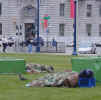homefires
april
10, 2000. Days of our lives. No soap opera could duplicate the
scenario that Amos Brown has scripted. The powerful Baptist
minister gave a month’s notice to his tenants — a
grandmother, her disabled son, and two-year-old grandson — so
he could move in. The recipients of his un-Christian charity,
who survive on a Section 8 housing subsidy, turn out to be named
Love.
Brown says, "It’s my house, and I can do what I
want." What he wants is to be elected supervisor from
District 11. If the good preacher really feels his calling is to
serve this economically struggling district, surely Third
Baptist could be persuaded to sell the Ingleside Terrace house
where he currently resides and purchase one in Oceanview or
Excelsior, where "For Sale" signs abound. In the
present housing market, the church would make a tidy profit, and
the hostile criticism would subside.
On the other hand, it’s unlikely that Brown’s critics
would vote for him under any circumstances. And a second home,
outside the district, will provide a refuge when political
pressures overwhelm.
Monsters on the march. The construction boom is moving
west. As residents of Noe Valley watch in frustration,
developers are razing small, single-family houses and erecting
"monster homes" and multi-unit condos in their place.
It’s a march gone mad, observes Jeannene Przblyski in the Noe
Valley Voice: "The Planning Department has no road map
for reasonable development, no set of guidelines for planned
growth in the residential neighborhoods."
The Collingwood Hill Neighborhood Association is trying to
quell the invasion, which threatens the neighborhood’s
traditional economic diversity. (Sound familiar?) But once
again, it’s a case of amateurs against the pros. Land-use
attorneys refuse to help, "conflicted out" because of
their association with developers. The association finds itself
scrambling as developers demand speeded-up hearing processes.
The solution, Przblyski argues, is a moratorium on new
demolitions and residential constructions while we take a good
hard look at the kind of city we want to create.
Jeannene Przblyski receives mail at jprzy@pacbell.net

Mi casa es su casa. City Hall is "not Taj Ma-Willie.
It's your building,'' Our Mayor announced hospitably as he cut a
ribbon in front of the refurbished building a year ago. Echoes
of his statement hovered over Civic Plaza last Tuesday, where a
couple of sleeping bags had set up camp, their
camouflage-colored olive and tan covers standing out against the
bright green lawn. The picture springs to mind of City Hall’s
vast lobby lined with sleeping bags and shopping carts, serving
the people on a second shift, after the suits and tourists have
left for the day.
Mike Weiss reported in a recent Sunday Examiner article that
homeless people are putting the new library to good use. Of
special value are the restrooms, a private place to clean up and
change clothes. The new City Hall’s restrooms are large and
clean, located just behind the café at the edge of the lobby.
The only barrier — visitors must pass through the metal
detectors to reach them.